
Henning Holck-Larsen was a Danish engineer who co-founded the Indian engineering firm Larsen & Toubro (L&T).

Vester Voldgade is a street in Copenhagen, Denmark which runs from Jarmers Plads to the waterfront between Frederiksholms Kanal and Langebro, passing the City Hall Square on the way.
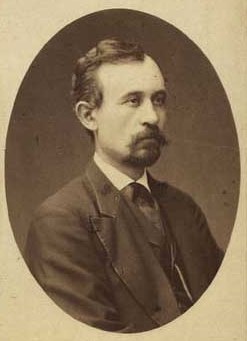
Hans Ludvig Smidth was a Danish painter. He is remembered above all for his paintings of Jutland and its local inhabitants.

Dantes Plads is a public square located in front of the Ny Carlsberg Glyptotek where it connects H. C. Andersens Boulevard to Vester Voldgade in central Copenhagen, Denmark.

Vestergade is a street in central Copenhagen, Denmark, linking Gammeltorv in the northeast with the City Hall Square in the southwest. The street defines the southern boundary of Copenhagen's Latin Quarter. Most of the buildings in the street date from the years after the Copenhagen Fire of 1795.

Philip Smidth was a prolific Danish architect in the late 19th and early 20th centuries. His works included, commercial properties, high-end apartment buildings, hotels and hospitals. He worked in the Historicist style. Two of his works, Liselund Ny Slot on the island of Møn and Gefion and Gylfe in Copenhagen, have been listed by the Danish Heritage Agency.

Chr. Augustinus Fabrikker is a former Danish tobacco company which now serves as the investment company of the Augustinus Foundation.

Tre Hjorter is a former hotel located on the corner of Vestergade and Larsbjørnstræde in the Latin Quarter of central Copenhagen, Denmark. It now houses a bar on the ground floor. The building was listed on the Danish registry of protected buildings and places in 1939.

Vestergade 14 is a property located at the corner of Vestergade and Larsbjørnsstræde in the Latin Quarter of Copenhagen, Denmark. No. 14 and the neighbouring building at No. 16 were jointly listed on the Danish registry of protected buildings and places in 1939.

Larsbjørnsstræde is a street in the Latin Quarter of central Copenhagen, Denmark. It runs from Vestergade in the south to Sankt Peders Stræde in the north, linking Kattesundet to Teglgårdsstræde. Many of the buildings in the street date from the years after the Copenhagen Fire of 1795 and have been listed on the Danish registry of protected buildings and places.
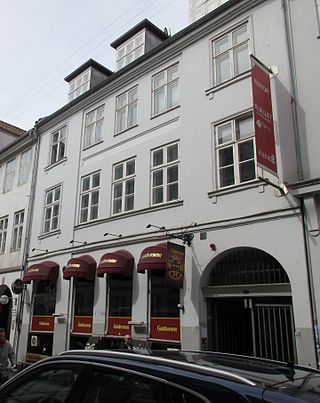
Vestergade 20 is a Neoclassical property in the Latin Quarter of Copenhagen, Denmark. The building was operated as a guesthouse under the name Vinkanden and the name was later changed to Dannebrog. The current building was constructed after the Copenhagen Fire of 1795. It housed J. E. Felumb's piano factory from 1882. It was listed on the Danish registry of protected buildings and places in 1939.

Ny Vestergade 9 is an 18th-century building located across the street from the main entrance to the National Museum in central Copenhagen, Denmark. Former owners include court painter Hendrick Krock, printmaker Hans Qvist, Royal Armourer Christian Kyhl and wholesaler Jacob Stilling-Andersen. The building was listed in the Danish Registry of Protected Buildings and Places in 1932.

Vestergade 1 is a Neoclassical property located at the corner of Gammeltorv and the street Vestergade in the Old Town of Copenhagen, Denmark. The facade towards Gammeltorv and Vestergade meet in an Obtuse angle with four bays towards the square and five bays towards the street. The building was listed in the Danish registry of protected buildings and places in 1950. Café Gammel Torv, a traditional Danish lunch restaurant, has since 1910 been based in the basement at Gammeltorv 20. The building/restaurant is now colloquially known as The House With The Green Tree after an eponymous 1942 novel by Kalvin Lindemann.
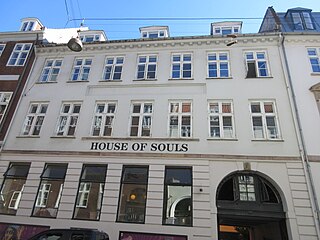
Vestergade 3 is a Neoclassical property in the Old Town of Copenhagen, Denmark. The building was constructed as part of the rebuilding of the city following the Copenhagen Fire of 1795. It was listed in the Danish registry of protected buildings and places in 1959. Notable former residents include the clergy Christian Bastholm and the painters Albert Küchler and Jørgen Roed.
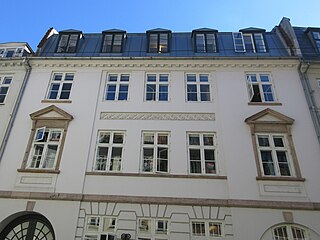
Vestergade 5 is a Neoclassical property in the Old Town of Copenhagen, Denmark. The building was constructed for the owner of the tobacco manufacturer Chr. Augustinus Fabrikker in 1797 and the company was until 1870 based in the complex. It was listed in the Danish registry of protected buildings and places in 1918.

Vestergade 24 is a Neoclassical property in the Latin Quarter of Copenhagen, Denmark. It is now part of the newspaper Politiken's headquarters, The building was listed on the Danish registry of protected buildings and places in 1959.
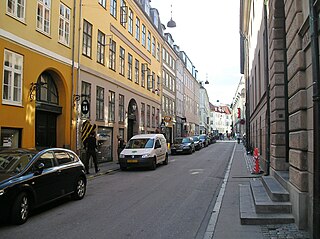
Kattesundet is a side street to the shopping street Strøget in the Old Town of Copenhagen, Denmark. It runs from Vestergade in the northwest to Lavendelstræde-Slutterigade in the southeast, linking Larsbjørnsstræde with Hestemøllestræde. The buildings that line the southwest side of the street all date from the years after the Copenhagen Fire of 1795. Six of them, No. 2 and No. 10-18, are listed in the Danish registry of protected buildings and places. The other side of the street is dominated by the rear side of Copenhagen Court House and the Anton Rosen Jugendstil Metropol Building from 1908.
Frantz Philip Nicolai Lange was a Danish architect and master mason. He made a significant contribution to the rebuilding of Copenhagen in the years after the Copenhagen Fire of 1795. Most of his buildings have been listed on the Danish registry of protected buildings and places.

Vestergade 22 is a Neoclassical property in the Latin Quarter of Copenhagen, Denmark. The building is now part of the Politiken Hus complex. A commemorative plaque mounted on the wall of the gateway summarizes the history of the property, including the fact that Anders Sandøe Ørsted and his wife Sophie lived in the apartment on the first floor from 1805 to 1813. The building was listed on the Danish registry of protected buildings and places in 1959.
Lauritz Laurberg Thrane (1757–1809) was a Danish master mason architect and builder. He was one of the most active master builders in Copenhagen during the 1790s and 1800s, contributing to the rebuilding of the city following the Copenhagen Fire of 1795. Many of his surviving buildings have been added to the Danish registry of protected buildings and places.




















